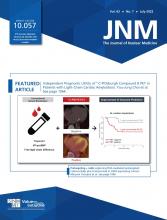TO THE EDITOR: We thank Prive et al. for their correspondence. As acknowledged in our publication (1), the main limitation of the study is the use of a single-time-point SUV measurement as a surrogate for radiation dose. Differential prostate-specific membrane antigen (PSMA) uptake patterns and tumor-to-background ratios are observed when PSMA PET image acquisition is performed at late time points in comparison to images acquired at 1 h after injection (2–5). Thus, it is clear that images acquired 1 h after injection cannot reflect the biologic effects of 177Lu-PSMA that occur over more than 3 wk (biologic half-life). However, even if not perfectly accurate, PSMA PET imaging performed at 1 h still provides a fair estimate of the patient target expression and of the biodistribution of a PSMA-targeted radiopharmaceutical, and prior studies have reported that pretherapeutic PSMA PET measurements may be correlated with radiation dose to tumor and normal organs from 177Lu-PSMA therapy (6–8).
Regarding the definition of low- and high-volume disease, it is important to note that CHAARTED and LATTITUDE criteria were based on conventional imaging (9). Applying these criteria for an analysis of PSMA PET can lead to major discordance in patient stratification, as described previously (10). Therefore, we recommend explicit use of the term PSMA-VOL in reference to the whole-body PSMA PET volumetric assessment and not just low-volume or high-volume metastatic, as follows: very low PSMA-VOL (<25 cm3), low PSMA-VOL (25–188 cm3), moderate PSMA-VOL (189–531 cm3), high PSMA-VOL (532–1,354 cm3), and very high PSMA-VOL (≥1,355 cm3).
As the authors mention, we agree that patients with low-volume metastatic disease or oligometastases can safely benefit from PSMA-based radionuclide therapy without decreasing the commonly applied dose-activity level of 7.4 GBq per cycle currently in use in the ongoing trial NCT04443062 and as supported by preliminary data (11). On the other hand, our results suggest that the dose-activity level of 177Lu-PSMA could be increased safely in patients with very high PSMA-VOL (≥1,355 cm3). Nevertheless, these findings warrant further validation by dosimetry studies and safety assessments in prospective clinical trials.
Footnotes
Published online Apr. 28, 2022.
- © 2022 by the Society of Nuclear Medicine and Molecular Imaging.







